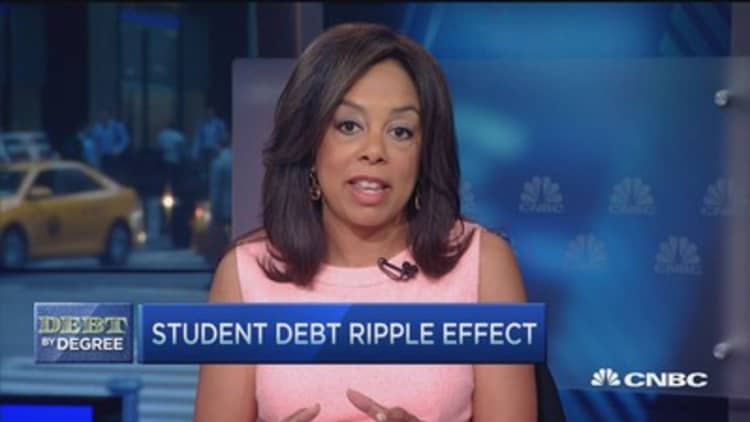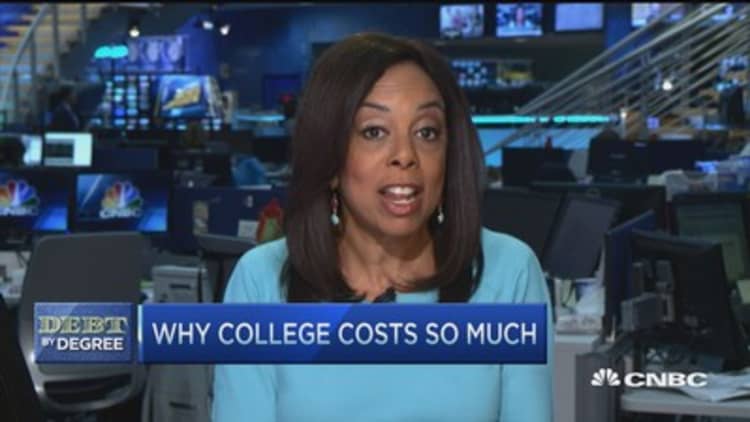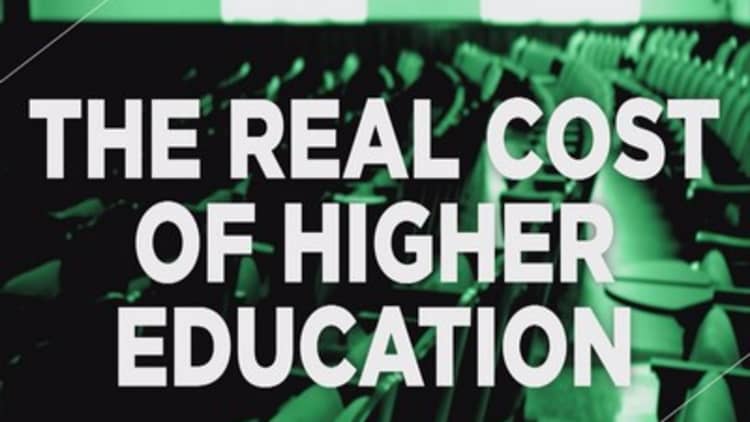


Rising student debt levels certainly seem unsustainable. Over the past 10 years, student loan debt has more than tripled from $360 billion in 2005 to more than $1.2 trillion today, making it second only to outstanding mortgage debt.
Meanwhile, student loan delinquencies have surged from 6 percent a decade ago to more than 11 percent at the end of last year, far higher than the delinquency rate for any other type of debt. (Tweet This)
Those worrisome trends have everyone from student activists to Silicon Valley entrepreneurs and presidential candidates pushing proposals to stem the rising tide of student debt—some aimed at making higher education more affordable and others at helping borrowers deal with, or even dismiss, high loan balances.
While it's too soon to know which approach may ultimately be successful, many have the potential to change the financial fortunes of millions of future students and their families.
Debt-free college?
In February, President Barack Obama proposed a scaled-back version of what would be a radical idea for Americans: free tuition for community college students.
Obama's plan would offer free tuition to students who attend classes at least half time and maintain a grade point average of 2.5 or better. In announcing a resolution that backed the concept, Sen. Chuck Schumer, D-N.Y., called debt-free college "the next big idea." The measure has received support from Sen. Elizabeth Warren, D.-Mass, a lawmaker popular with the party's liberal wing.
Read MoreThe high costs of student loan debt
"Our economy cannot flourish if we don't have enough college-educated workers, but our economy will stagnate if students take on bigger and bigger debt loads to pay for college. Degrees push us forward, but debt holds us back," Warren said June 10 when outlining her proposals to address the affordability of college.
"While not every college needs to graduate every student debt free, every kid needs a debt-free option—a strong public university where it's possible to get a great education without taking on loads of debt," she added.
Presidential candidates weigh in
Student loan debt is sure to be a major issue in the 2016 presidential elections. In a June 13 campaign speech, former Secretary of State Hillary Clinton said she wanted to "make college affordable and available to all … and lift the crushing burden of student debt." Other candidates seeking the Democratic nomination, Sen. Bernie Sanders of Vermont and former Maryland Gov. Martin O'Malley, have explicitly supported so-called debt-free college.
But those on the right have argued that offering free tuition may be going too far. "I don't think the target should be free," said Andrew Kelly, director of the American Enterprise Institute's Center on Higher Education Reform. "Our target should be opportunity."
Republican presidential candidates are offering their own solutions, many focused on easing the burden on borrowers.
Sen. Rand Paul of Kentucky proposed letting "college students deduct the cost of their education over their working career." Sen. Marco Rubio of Florida co-sponsored a bipartisan bill last year that would allow more federal student loan borrowers to make repayments based on their income. (There are already three different income-driven repayment options for federal loans.)
Former Florida Gov. Jeb Bush has called "for more accountability so at least parents and students know which universities are really fulfilling their mission of getting students out of college with a degree that will allow them to have a job."
Expanding aid and access
The expansion of existing federal and state programs and funding can also help reduce the risks and ease the burdens of student debt. "Two things need to happen ... increase state investment in higher education and increase access to need-based aid," said Lauren Asher, president of The Institute for College Access & Success, a nonprofit policy and research organization.
Asher recommends expanding federal Pell Grants, which more than 8 million low-income Americans depend on to attend college. In the 1980s, the maximum Pell Grant covered more than half the cost of attending a four-year public college. Now the $5,775 maximum Pell Grant for the 2015-16 academic year is expected to cover less than one-third of the cost of college—the lowest amount in more than 40 years, Asher said. (Tweet This)
Read MoreThe real reasons a college degree costs so much
More states are seeking to expand affordable higher education options by letting community colleges offer four-year degrees from the traditional two-year associate degrees.
In January, California joined 21 states that allow its community colleges to provide bachelor's degrees.
The average cost of tuition and fees at a community college was $3,347 in the 2014-2015 academic year, according to the College Board. That's 60 percent less than the average in-state tuition and fees at public four-year universities and 90 percent less than at private colleges. (Tweet This)
Helping high-balance borrowers
Making college more affordable does nothing to help struggling borrowers who have graduated, though, and little to help those who have dropped out of school with high levels of student loan debt. The Federal Reserve Bank of New York estimates that 17 percent of all student loan borrowers are in default or delinquency.
While federal student loans offer options to avoid default through income-driven repayment programs, lenders and servicers of private student loans generally do not.
But one legal fix, which the Consumer Financial Protection Bureau (CFPB) has recommended, would make it easier to discharge private student loan debt in bankruptcy.
Read MoreHow to win the game of student loans
In 2005, the bankruptcy code was amended so that all private loans made for a qualified education expense became exempt from discharge in bankruptcy without "undue hardship" to the debtor. The special treatment of private student loan debt caused a moderate expansion of credit for less creditworthy borrowers and led to a slight increase in the cost of private loans at four-year undergraduate colleges, according to a 2014 study by University of Connecticut School of Law and CFPB researchers.
Asher and others are pushing to remove the exemption. "We need to treat private student loans like any other type of consumer debt," she said. "It's easier to discharge gambling debt in bankruptcy than private student loan debt."
New entrants into the student loan market have offered some private solutions to help many borrowers, though, especially those with excellent credit.
For example, SoFi, which is on the 2015 CNBC Disruptor 50 list, has refinanced $2.5 billion in student loans for more than 40,000 borrowers at lower rates since 2012. "For some borrowers, we are slashing their interest rates in half," said Daniel Macklin, SoFi's co-founder.
Read MoreStart a business? Retire well? Not with student loans
However, refinancing means that borrowers will lose the flexibility and protections in their repayment options that come with federal student loans.
Striking for a fairer system
Some borrowers have struck back themselves, refusing to repay their student loans.
Nearly former 200 students at the Corinthian Colleges, which shut down abruptly earlier this year, have said they will not repay their federal loans after the U.S. Department of Education found that the former, for-profit college operator charged outrageous fees and lied about their job placement figures. The so-called "debt strikers" petitioned for their loans to be automatically forgiven.
On June 8, the department agreed to erase much of the debt carried by Corinthian students as part of a new plan that could cost taxpayers as much as $3.6 billion.
However, the debt strikers, through their organization The Debt Collective (an offshoot of the Occupy Wall Street movement), called the plan "a bureaucratically tortured process designed to provide relief only to those who hear about it and can figure out how to navigate unnecessary red tape."
Read More
More than 1,200 people have pledged to not pay their student loans in solidarity with the Corinthian students if theEducation Department doesn't automatically forgive the loans of Corinthian students, according to the Debt Collective.
The debt strike is only the first step in reforming the student loan system, said Laura Hanna, an organizer with the Debt Collective. "We are renewing the call that access to quality higher education is a right," she said.
Access to higher education may not be a legal right, but it is a deeply ingrained American value. And that bodes well for some relief to come, even if it's not yet clear what form it will take.


